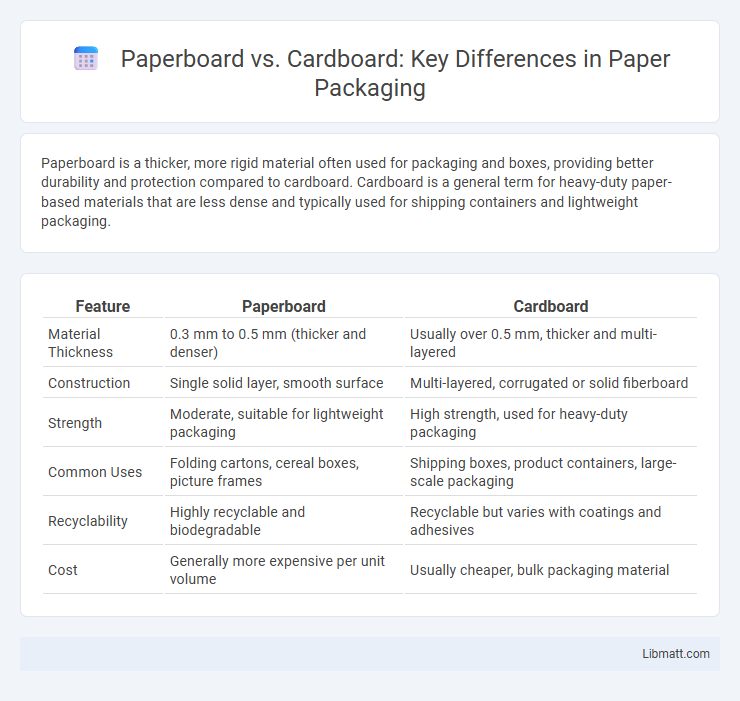Paperboard is a thicker, more rigid material often used for packaging and boxes, providing better durability and protection compared to cardboard. Cardboard is a general term for heavy-duty paper-based materials that are less dense and typically used for shipping containers and lightweight packaging.
Table of Comparison
| Feature | Paperboard | Cardboard |
|---|---|---|
| Material Thickness | 0.3 mm to 0.5 mm (thicker and denser) | Usually over 0.5 mm, thicker and multi-layered |
| Construction | Single solid layer, smooth surface | Multi-layered, corrugated or solid fiberboard |
| Strength | Moderate, suitable for lightweight packaging | High strength, used for heavy-duty packaging |
| Common Uses | Folding cartons, cereal boxes, picture frames | Shipping boxes, product containers, large-scale packaging |
| Recyclability | Highly recyclable and biodegradable | Recyclable but varies with coatings and adhesives |
| Cost | Generally more expensive per unit volume | Usually cheaper, bulk packaging material |
Understanding Paperboard and Cardboard
Paperboard is a thick, durable paper-based material typically used for packaging, while cardboard is a broader term encompassing various heavy paper materials including paperboard and corrugated fiberboard. You can distinguish paperboard by its single-ply structure and smooth surface, ideal for printing and lightweight packaging applications. Cardboard often refers to multi-layered, corrugated structures designed for sturdier protective packaging and shipping solutions.
Key Differences Between Paperboard and Cardboard
Paperboard is a thick, solid paper-based material typically used for packaging lightweight items, offering rigidity and smooth surfaces ideal for printing. Cardboard is a broader term often referring to corrugated fiberboard, which consists of a fluted corrugated sheet sandwiched between two liners, providing enhanced strength and cushioning for shipping heavy products. The key differences lie in thickness, durability, and typical applications: paperboard is thinner and more suited for retail packaging, while cardboard is thicker and designed for structural support and protection during transportation.
Composition and Material Properties
Paperboard is a thick, multi-layered paper-based material primarily composed of cellulose fibers, offering rigidity and smooth surfaces ideal for printing and packaging. Cardboard, often made from recycled paper fibers, features a fluted corrugated core sandwiched between flat linerboards, providing enhanced strength and cushioning properties for shipping and storage. The density and fiber arrangement in paperboard contribute to its lightweight and solid surface, while cardboard's layered structure delivers superior impact resistance and durability.
Manufacturing Processes Compared
Paperboard and cardboard differ primarily in thickness and manufacturing complexity, with paperboard produced through a controlled layering of pulp fibers on a multi-ply machine creating a smooth, dense sheet ideal for packaging applications. Cardboard often refers to a broader category including corrugated fiberboard, constructed by sandwiching a fluted corrugated sheet between linerboards, involving a more complex manufacturing process that adds rigidity and cushioning. The choice between paperboard and cardboard hinges on the required strength, durability, and specific use-case, where paperboard's simpler, single-layer production contrasts with cardboard's composite layering for enhanced structural performance.
Common Uses of Paperboard
Paperboard is widely used in packaging for products like cereal boxes, cosmetics, and pharmaceuticals due to its lightweight and sturdy properties. Its high printability makes it ideal for branding and product information display on retail packaging. Paperboard also serves in crafting cartons, trays, and backing for notepads, providing both functionality and sustainability benefits.
Popular Applications of Cardboard
Cardboard is widely used in packaging for shipping boxes, retail product containers, and protective inserts due to its durability and cost-effectiveness. It also serves as a common material for crafting, signage, and promotional displays, benefiting from its ease of cutting and printing. Its lightweight nature makes cardboard ideal for bulk packaging and recyclable shipping solutions across various industries.
Durability and Strength Comparison
Paperboard offers superior durability and strength compared to standard cardboard due to its thicker, denser material composition and rigid structure. Its high-quality fiber content enhances resistance to bending and crushing, making it ideal for packaging heavy or fragile items. When choosing materials for your packaging needs, paperboard ensures better protection and longevity than typical corrugated cardboard.
Environmental Impact and Sustainability
Paperboard and cardboard differ significantly in environmental impact and sustainability, with paperboard typically made from recycled paper fibers, making it more eco-friendly and easier to recycle. Cardboard, especially corrugated varieties, often requires more resources and energy to produce but offers superior durability and recyclability, supporting waste reduction through reuse. Choosing paperboard or cardboard for your packaging depends on balancing environmental priorities with practical needs such as strength and end-of-life disposal options.
Cost Considerations and Availability
Paperboard offers a cost-effective option for packaging due to its lightweight nature and ease of production, making it widely available for a variety of uses. Cardboard, often thicker and more durable, tends to be slightly more expensive but provides superior protection for heavier items. Your choice between paperboard and cardboard should consider both budget constraints and the availability of materials specific to your packaging needs.
Choosing the Right Material: Paperboard or Cardboard
Choosing the right material between paperboard and cardboard depends on your packaging needs and product protection requirements. Paperboard offers a smooth surface ideal for printing and lightweight packaging, while cardboard provides superior strength and durability for heavier items. Assess your product's weight, shipping conditions, and design preferences to determine whether paperboard or cardboard best suits your project.
Paperboard vs cardboard Infographic

 libmatt.com
libmatt.com